Imagining new futures for the flyover
Winners lay out visions for transforming demolition-threatened Gateshead flyover. Tony Henderson reports.
Demolishing the Gateshead Flyover - built in 1967 and made of thousands of tonnes of reinforced concrete - would waste embodied carbon equivalent to 30 million car miles.
It would also discard the chance to repurpose the structure as a civic landmark and green corridor in the heart of the town.
That’s the message from four winning entries in a competition organised by Newcastle University’s Farrell Centre, which invited bold ideas to reimagine the now-closed flyover.
“Using the opportunity of the sudden closure of the Gateshead Flyover and its now impending demolition, we asked entrants to explore possibilities for re-using, re-imagining and re-constituting the flyover and what that could offer the town and the region from the environmental and economic upsides, to the opportunities for supporting health, wellbeing and civic pride,” said centre director Owen Hopkins.
Entries were judged by a panel of Dr Paola Gazzola, head of the School of Architecture, Planning and Landscape at Newcastle University; Neil Barker, architect and president of the Northern Architectural Association; Richard J. Williams, professor of contemporary Visual Cultures, University of Edinburgh; and Dr Alistair Ford, senior lecturer in geospatial data analytics at Newcastle University.
“We were overwhelmed by the quality of the submission and our judges had a hard time selecting the four winners,” said Mr Hopkins.
One of the winning concepts was The Gateshead Urban Pier by North East-based Max Cooper-Clark - an artist, researcher and writer with an MA in architecture who has exhibited internationally and received recognition for his proposals to retain and reimagine post-war concrete megastructures.
“The Gateshead Urban Pier reimagines the flyover – once a barrier of concrete and car dominance – as a vibrant, inclusive public space,” he says.
“The 1960s infrastructure fragmented the riverside, making land and air inaccessible to people and nature alike. This proposal transforms the elevated motorway into a dynamic urban pier, inspired by medieval bridges and Victorian piers, offering a new landscape of health, ecology, and social life.”
Accessed via existing ramps and new lift towers, the preserved structure would include ecological walkways, community allotments and raised playscapes. Beneath, the undercroft becomes a hub for local life - with sports facilities, markets, laundrettes, repair shops and even a cinema.
He says: “The Central Motorway and Gateshead Highway have enveloped the river in a tangle of impassable concrete. Multilevel roads have rendered the air, land and soil inaccessible.
“This vision turns a divisive structure into a platform of connectivity and regeneration - supporting biodiversity, fostering community, and providing essential amenities. The Urban Pier becomes a destination where Gateshead can flourish.”
The Flyover Commons vision is by Tonkin Liu and Ash Sakula Architects and OURI Labs. They say the flyover was an enormous public investment, both financially and environmentally.
“We see the opportunity for transforming the flyover into a vibrant civic and ecological asset.
“Flyover Commons reimagines the structure as a lush, elevated landscape. Features include rainwater-fed community gardens, misting systems, biofiltration gardens, and glowing mesh tubes that channel water into underground reservoirs. Above, is a walkway with fruit trees, ecology labs, and solar-powered kiosks.
“The project aims to become a new heart for Gateshead, offering a model for reusing redundant infrastructure to shape a greener, more connected town centre.
“We propose a visionary rewilding and reworking of the Gateshead Flyover into an elevated verdant landscape.”
Gateshead Renewal is the vision from urban design and architectural practice EcoResponsive Environments.
They say: “When urban structures like the Gateshead Flyover fall into disuse they don’t just mark an end, but signal a beginning. Inspired by natural regeneration, this proposal for the flyover’s reimagining sees it as a living framework that fosters social connection, ecological health, and community well-being.
“Our vision for the flyover emphasises reconnecting spaces, revitalizing local economies, restoring biodiversity, and sustainable mobility.
“The flyover shifts from a divisive structure to a connective seam – where nature, infrastructure, and everyday life interweave. Owned by the community through the Gateshead Trust, the project reinvests the local growth it creates via affordable rents, skills training, arts, and green technology – which turns a forgotten infrastructure into a thriving, inclusive civic landscape.”
This vision combines layers of natural habitats including a park, water features, and community and mobility uses.
Community and Connectivity in Nature: Reclaiming the Flyover for Gateshead was the winning entry from the architects and designers at Colour, a studio founded to reshape the role of landscape architecture in the 21st century.
They say: “This proposal reimagines the Gateshead Flyover as a vibrant, inclusive civic space that reconnects people, nature, and neighbourhoods at the heart of the town.
“Once a symbol of division and car dominance, the flyover is transformed into a green public asset that supports biodiversity, fosters community life, and improves connectivity.
“Currently limited in pedestrian and cycle access and lacking in green space, the site sits in one of the UK’s most deprived areas – making regeneration vital.”






The flyover’s immense thermal mass could passively regulate microclimates, supporting year-round greenhouses. It may also serve as a carbon capture testbed or a perch for urban wind energy turbines.